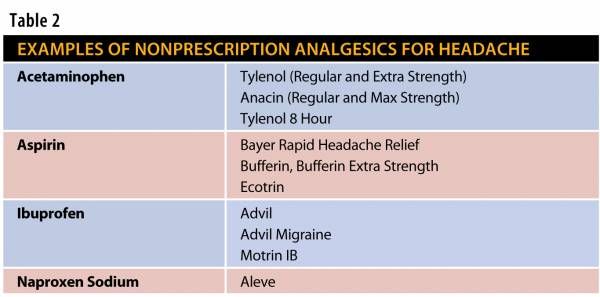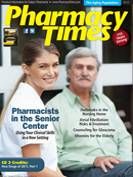Alleviating Headache Pain
Headaches drive patients to the pharmacist's counter every day for help finding appropriate treatment.
Headaches drive patients to the pharmacist's counter every day for help finding appropriate treatment.
Nonprescription analgesics for the management of headaches are widely utilized by many patients; however, the selection of these products may be overwhelming. It is estimated that 33% of OTC analgesics are used for the treatment and management of headaches.1 According to the American Headache Society, many patients choose these products because they are easy to obtain and use, and cost less than prescription medications.2 The Handbook of Nonprescription Drugs states that the types of headaches most often amendable to self-treatment with nonprescription analgesics include tension-type headaches, migraines, and sinus headaches.1
Pharmacists are in a pivotal position to assist patients in the selection and proper use of these products and to screen for possible contraindications, drug—drug interactions, and potential therapeutic duplications. By reviewing a patient’s medication profile, pharmacists can identify pharmacologic agents that may trigger headaches, provide clinical recommendations, and encourage patients to discuss the issue with their primary health care provider.
Headache Triggers
Headaches may be caused by a number of factors, which can include stress, anxiety, environmental factors such as noise, poor lighting conditions when reading or using a computer, significant changes in sleeping and eating patterns (eg, skipping meals or not getting enough sleep), use of certain pharmacologic agents, fluctuations of hormone levels, and food sensitivities. 1,3
Types of Headaches
In general, headaches are categorized as OTC focus A Pharmacist’s Guide to OTC Therapy Yvette C. Terrie, BSPharm, RPh Pharmacists Play a Critical Role in Helping Patients Select the Right Product to Manage Headaches Safely and Appropriately primary or secondary.1,4 Primary headaches account for an estimated 90% of headaches and are not linked to an underlying illness.4 According to the American Headache Society, examples of primary headaches include tension headache, cluster headache, migraine, and medication overuse headaches (also known as rebound headaches).1,4-6
A headache is classified as secondary when it is the result of an underlying medical condition.1,4-6 Some of the conditions that may cause secondary headaches include sinusitis, severe hypertension, head trauma, hematomas, temporomandibular joint dysfunction, metabolic disorders, cerebral hemorrhage, and meningitis. 1,7-9 Patients experiencing secondary headaches should always be referred to their primary health care provider for further medical evaluation and treatment.
Tension Headaches
Tension headaches—commonly referred to as stress headaches—are considered the most prevalent type of headache, affecting an estimated 75% of individuals in the United States.4 They occur most commonly in women.1,4 Tension headaches may be classified as episodic or chronic,1 and are characterized by mild pain that gradually initiates at the back of the head and upper neck. The pain is usually bilateral and is often described as tight, pressing, and constricting.1,4-6 The duration of tension headaches ranges from minutes to days.1-3 Stress, anxiety, fatigue, eyestrain from reading and computer use, and muscular tension are common causes of tension headaches.1,6 Patients who experience frequent and/ or chronic tension headaches should be referred to a physician for further evaluation. 5
Migraine Headaches
Migraines affect approximately 12% of the US population and occur most often in individuals aged 15 to 55 years.9 Most individuals experience their first migraine before age 30.1,8,9 Migraines occur in an estimated 18% of women and 6% of men.1,7 In addition, an estimated 4% to 10% of the pediatric population experience migraines.8,10 About 70% to 80% of migraine sufferers have a family member with a history of migraines.1,8,9
Migraine headaches are characterized by pain that is typically unilateral and is often described as intense and throbbing. 1-3 The pain associated with migraine headaches may be preceded by aura and onset may be abrupt; however, some patients do not experience aura. Patients may report sensitivity to light, noise, or odors and may experience nausea and vomiting.1-4 The duration of migraines usually ranges from a few hours to about 72 hours.4 Many women experience migraine attacks during the premenstrual cycle. Migraines, however, may also occur during and after the menstrual cycle.1 Women may also experience migraines during perimenopause and menopause.

Nonprescription analgesics available for the treatment and management of headaches include acetaminophen, nonsteroidal anti-inflammatory drugs including ibuprofen and naproxen, and salicylates (aspirin, magnesium salicylate, and sodium salicylate). 1 These products are available in a variety of formulations as single entity or combination products, such as tablets, capsules, gel capsules, liquigels, enteric coated, extended or sustained release forms, liquids, suspensions, effervescent tablets, rapid release gel capsules, powders, and chewable tablets. Combination products include decongestants, antihistamines, and analgesics for treating sinus headaches. Patients should be advised to read labels carefully, especially when using multi-ingredient products, to avoid unnecessary drug use or therapeutic duplications.
In addition, several alternative medications are available for the relief and management of headache symptoms, including Hylands Headache Tablets, and topical products such as WellPatch Migraine Cooling Therapy Pads. New products on the market include Sinol All-Natural Nasal Spray with MucoAd for Fast Headache Relief, and Headache Buster Nasal Spray, which includes 3 active ingredients: capsaicin, feverfew, and peppermint oil.11,12
The Role of the Pharmacist
Prior to recommending any nonprescription analgesics, pharmacists should always screen for potential allergies, contraindications, and drug—drug interactions. Identifying possible triggers and avoiding and modifying them can help decrease the frequency of headaches in patients who experience frequent tension or migraine headaches.1 Nonpharmacologic measures that may be beneficial in alleviating or preventing headaches include relaxation techniques, avoiding stress, eating a balanced diet, and getting an adequate amount of sleep.
During counseling, patients should be reminded about the proper use of analgesics, including recommended duration, and should be advised to take these products with food or milk if they experience an upset stomach. Patients should also be counseled on the potential adverse effects associated with the use of these products.
Although the majority of headaches can be easily managed and only last a few hours, patients should be encouraged to seek further medical care if they do not obtain any relief after using these products, if they experience chronic headaches, or if headaches increase in intensity or frequency. Patients should also be reminded that excessive use of these products could lead to rebound headaches or medication overuse headaches.1
Table 3: Combination Products
Active Ingredients
Brand Name
Acetaminophen and phenylephrine
Excedrin Aspirin Free Sinus Headache
Sudafed PE Sinus Pressure Pain
Naproxen sodium and pseudoephedrine
Aleve-D Sinus & Cold
Acetaminophen, aspirin, and caffeine
Anacin Advanced Headache Formula
Excedrin Migraine
Excedrin Extra Strength
Goody’s Extra Strength Headache Powders
Vanquish Extra-Strength Pain Reliever
Good Sense Added Strength Headache Relief
Aluminum hydroxide, aspirin, calcium carbonate, and magnesium hydroxide
Ascriptin Maximum Strength Pain Reliever
Acetaminophen and caffeine
Excedrin Tension Headache
Acetaminiphen, diphenhyramine, and phenylephrine
Benadryl Allergy Plus Sinus Headache
Table 4: Topical Products
Well Patch Migraine Cooling Headache Pads
HeadOn Topical Treatment (formulations available include HeadOn Tension, HeadOn Extra Strength, HeadOn Migraine, HeadOn PM, HeadOn Sinus Headache Relief)
Sinol All-Natural Nasal Spray with MucoAd
Table 5. Exclusions for Self-Treatment
· Patients experiencing severe headaches
· Those with recent head trauma
· Those with a history of hepatic disease or those who consume 3 or more drinks daily
· Those experiencing secondary headaches
· Patients younger than 8 years of age
· Those who exhibit symptoms of migraines but have not been formally diagnosed as having migraines
Adapted from reference 1.
Table 6: Examples of Patient Counseling Tips Regarding Headaches and OTC Analgesics
If patient is pregnant, breast-feeding, taking any other medications or has a pre-existing medical condition, he or she should be encouraged to consult a primary health care provider prior to using OTC analgesics
The use of OTC analgesics for treatment of headache should be restricted to 3 days per week to avoid the potential of medication overuse headaches.
Do NOT use OTC analgesics for more than10 days unless directed by a physician and do not exceed the manufacturer’s recommended dosages or dosing intervals.
Naproxen should NOT be used in those aged 12 years and younger.
Patients who are allergic to aspirin or have asthma or nasal polyps should not take aspirin or NSAIDs; instead, acetaminophen should be taken when appropriate.
Do NOT take nonsteroidal anti-inflammatory drugs (NSAIDs) if the patient is at high risk for cardiovascular disease or stroke unless under the supervision of a physician.
Do NOT take aspirin or NSAIDs if the patient has a history of gastrointestinal disorders, ulcers, liver or kidney disease, or heart failure.
To avoid possible liver damage, limit acetaminophen to no more than 4 grams per day.
Do NOT take aspirin if currently taking medications for diabetes mellitus, gout, or arthritis unless directed by a primary healthcare provider.
Individuals with history of hepatic disease should avoid the use of acetaminophen.
Do NOT use salicylates or NSAIDs if taking anticoagulants.
Do NOT administer aspirin or other salicylates to children aged 15 years and younger who are recovering from chickenpox or symptoms of influenza.
Adapted from references 1 and 13.
Ms. Terrie is a clinical pharmacy writer based in Haymarket, Virginia.
References
1. Remington T. Headache. In: Berardi R, Newton G, McDermott JH, et al, eds. Handbook of Nonprescription Drugs. 16th ed. Washington, DC: American Pharmacists Association; 2009:65-81.
2. Acute therapy: why not over the counter or other nonspecific options? American Headache Society Web site. www.achenet.org/education/patients/AcuteTherapyWhyNotOvertheCounterorOtherNonspecificOptions.asp. Accessed November 27, 2011.
3. Top headache triggers. Tylenol Product Web site. www.tylenol.com/page.jhtml?id=tylenol/headbody/subftrig.inc. Accessed November 29, 2011.
4. Headaches. American College of Physicians Web site. www.acponline.org/patients_families/diseases_conditions/headaches/. Accessed November 27, 2011.
5. Types of headaches. American Headache Society Web site. www.achenet.org/resources/types_of_headaches/. Accessed November 26, 2011.
6. Tension type headaches. National Headache Foundation Web site. www.headaches.org/education/Headache_Topic_Sheets/Tension-Type_Headache. Accessed November 26, 2011.
7. Headache: hope through research. National Institute of Neurological Disorders and Stroke Web site. www.ninds.nih.gov/disorders/headache/detail_headache.htm. Accessed November 27, 2011.
8. Secondary headaches. American Headache Society Web site. www.achenet.org/education/patients/SecondaryHeadaches.asp. Accessed November 28, 2011.
9. Headaches. Merck Manual for Healthcare Professionals Online Edition. Merck Web site. www.merck.com/mmpe/sec16/ch216/ch216a.html#CACCDJAH. Accessed November 27, 2011.
10. Headaches in children. American Headache Society Web site. www.achenet.org/education/patients/HeadachesinChildren.asp. Accessed November 27, 2011.
11. Migraine. Medline Plus Web site. www.nlm.nih.gov/medlineplus/ency/article/000709.htm. Accessed November 26, 2011.
12. Headache Buster Nasal Spray product information. SiCap LLC Web site. www.busterbrands.com/products/headache-buster-nasal-spray/. Accessed November 27, 2011.
13. Sinol Nasal Spray for Headache Relief product information. Sinol USA Web site. www.sinolusa.com/. Accessed November 26, 2011.

